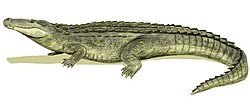| Brachyuranochampsa Temporal range: Middle Eocene, | |
|---|---|
| Scientific classification | |
| Kingdom: | Animalia |
| Phylum: | Chordata |
| Class: | Reptilia |
| Clade: | Archosauria |
| Order: | Crocodilia |
| Genus: | † Brachyuranochampsa Zangerl, 1944 |
| Species | |
| |
Brachyuranochampsa is an extinct genus of crocodilian.
The only robust occurrence of Brachyuranochampsa is B. eversolei from the Middle Eocene of Wyoming. [1] Another species, B. zangerli from the lower Bridger Formation at Grizzly Buttes, has been synonymized with another primitive crocodilian, "Crocodylus" affinis , also known from the Bridger Formation. [2] [3]
Phylogenetic studies have consistently recovered Brachyuranochampsa as more basal than the crown group Crocodylidae, which consists of all extant (living) crocodiles. [2] [4]
The below cladogram from a 2018 study combining morphological data and molecular DNA evidence shows the placement of Brachyuranochampsa within Crocodylia. [5]
| Crocodylia |
| ||||||||||||||||||||||||||||||||||||||||||||||||||||||||||||


